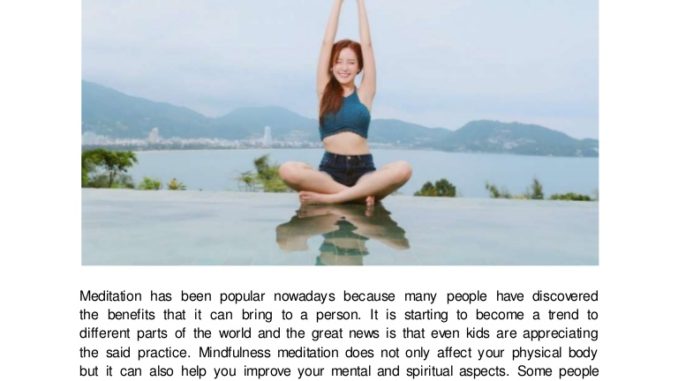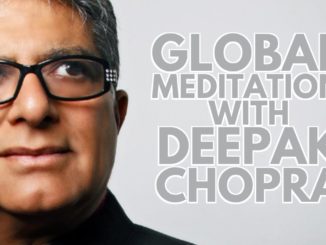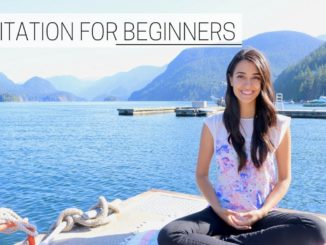
Years ago, during a rough patch in life, I started seeing a behavioral psychologist to deal with some anxiety issues and insomnia. Part of his sessions often consisted of a guided meditation, where he would speak to me in gentle tones while I lay on the sofa, breathing deeply. The meditations were probably a good 20 minutes or so, and frankly, I wondered if perhaps these sessions were just a way for my therapist to get a break from listening to my life nonsense, but I found them very relaxing and left afterwards feeling calm and refreshed, two feelings that didn’t come naturally to me.
After one session, my therapist complimented me on my breathing. He noted that I could slow my breath down and take very long, deep breaths that helped me reach a different state. Higher consciousness? Maybe. Calm and relaxed? Definitely, at least during and for a bit after the meditation. He asked if I had learned this somewhere. I told him about the years I had spent taking Kundalini Yoga from a prominent LA teacher. It wasn’t daily training, just a class or two a week with a bunch of other students in a studio or in the instructor’s living room.
“Breath of Fire” (very rapid in and out breath through the nose and controlled by the diaphragm) and techniques that included filling your lungs with as much air as possible (or blowing ALL the air out of your lungs and keeping them empty – always much harder), and then doing yoga while holding the air in or out is the kind of training that can improve breathing technique. There were also gong meditations, lying on your back, eyes closed, and breathing deeply while the instructor bangs on a large gong, which you hear as well as feel (sound waves) for the duration of the meditation.
My therapist then suggested, that as a massage therapist and massage therapy instructor, I might also teach people how to breathe. So, with that in mind, here are a few thoughts for those of you who want to incorporate a meditation practice into your life to reap its proven positive benefits, including:
· When to meditate and how often
· Creating a good mediation environment
· What you need to meditate
· Mantra or no mantra?
· Deep breathing techniques
· Clearing the mind (what to think about… or not)
· Benefits of Mediation
· “Mindfulness.” What does it really mean?
1. PICK A GOOD TIME AND START SMALL
Did you know that the Buddha sat under the Bodhi tree (ficus religiosa in Latin, which sounds like a Hermoine spell from Harry Potter) with the intention of remaining there until he achieved enlightenment? How long he actually sat is not entirely clear, but may have been weeks. Without food.
Good news: you don’t need to do that.
Start small. Most people who meditate “religiously” (it is spiritual, sometimes, but not necessarily religious, although even the Big 3 religions refer to silent or personal prayer as “meditation”) do so in the morning upon waking (and some do, in fact, get up at 4:30 for “sadna,” a pre-dawn meditation practiced by some Sikhs, when the spiritual energy is supposed to b especially strong), and then again in the late afternoon or early evening (before or after dinner is great).
Deep breathing before bed is a good way to relax, but a full meditation right before bed is not advisable because that might trick your body and brain into thinking you’ve slept enough already. And while early morning meditation seem to be fantastic for many, be realistic about yourself. Don’t make yourself get up at 5 or 6 to meditate if you hate getting up early. Do it when it’s convenient and easy for you, and then you’ll be more likely to keep doing it!
As for meditating for a week (or more) without food and water like the Buddha, this isn’t recommended for beginners or even the experienced. For most people, 15-20 minutes is a good session, but even five minutes is beneficial, and some long-time practitioners will do longer mediations. Starting out, five minutes is a good number because it’s easy to accomplish and will also give a novice a taste of the positive benefits. Try that for a few days, or a week, then move to 10 minutes, 15 minutes and finally 20 minutes. For me, and most meditators, 20 minutes seems to be the sweet spot.
2. BEST PLACES TO MEDITATE
Experienced meditators can meditate in an airport, a subway station, or a Trump campaign rally. But most prefer a quiet, not-too-bright location. Light is not an issue, but many find a darkened or dimly lit room (candlelight is great) more calming. Of course, the Buddha meditated outside, and many enjoy doing so on a stump in the woods or a rock on a mountain top or the sand on the beach. Whatever the locale, complete quiet (or soothing music or nature sounds) is best.
Thich Nhat Hanh famously says he does walking meditations in airports and on crowded city streets to the bemusement of the locals. Some meditation styles say to keep the eyes slightly open and focus on a space a few inches in front of your eyes. I’m of the “eye’s wide shut,” school. Experiment for yourself.
3. EQUIPMENT FOR MEDITATION
No special equipment is needed. All you need is you and a place to sit or lie down. Most meditate sitting up with a good, grounded posture. Lying down is fine, although it is easy to fall asleep this way, and sleeping is not meditating. Deep breathing is not a nap. Not that there’s anything wrong with a nap.
You might like a pillow to sit on. Some meditators prefer to sit up straight with a good posture, while others lean against a wall or cushion behind them, and might even meditate in a chair or couch. Some Buddhists use a flat, cushioned mat, and on that another pillow that is shaped kind of like a chocolate layer cake, maybe 8-10 inches across. Sitting on this cushion, with legs crossed on the mat or in a kneeling position, can feel very stable and comfortable.
Some sit in lotus or half lotus (cross legged with one ankle on the opposite knee for half lotus or both ankles on the opposite knee for full lotus). This is not easy for many, and even those who can sit this way will find that after a few minutes the foot gets uncomfortable or falls asleep. The main things to achieve in sitting position are comfort, so you are not distracted by discomfort, and good posture. Whatever position allows this, including lying down, is fine.
Candles, incense and music can enhance meditation. If you want music, it is best to listen to something non-melodic, like chimes or bells or random flute and nature sounds. Or nothing. Music with words or melody or rhythm is distracting and should be avoided. Nature sounds, like the ocean or a stream or rain can be wonderful, especially if you live in an urban area with traffic sounds, sirens, people’s music, garbage trucks, etc., because the sounds can help mute the environmental aural clutter.
A great investment is a kitchen timer. You can also use a timer on your smart phone (or even your dumb phone if you don’t have a smart one). I use a kitchen timer that I got before smart phones were a thing. I punch in the amount of time I want to meditate (usually 20 minutes, although I add a minute to allow myself time to settle in), and that’s it. Why a timer? Then you don’t need to check the clock. And when you start out, you’ll want to check the clock a lot, and when you do, after feeling like you’ve meditated for a half-hour and look to see it’s been under four minutes, you’ll see what’s so great about a timer.
4. MANTRA OR NO MANTRA?
Good question. I’ve tried both. Kundalini practitioners use, among other mantras, “ong namo gurudev namo,” which means “I bow to the teacher within me.” I like that because it feels non-religious. And there are tons of others. You don’t need to know what they mean, because it’s really about the saying or thinking of the mantra. The sound. The repetition. It helps you get in the right mindset. Not knowing the meaning is probably better. Those reared on praying in Hebrew or Latin might agree.
Remember: if you are a religious person and don’t feel comfortable taking part in religious ceremonies other than your own, mantras are not prayers. Some do sound like prayers, however. If this is an issue for you, either find a mantra that is completely secular, or repeat a short prayer from your own religious practice.
Some orgainized meditation movements or groups have been around for decades and cost a good deal of money. One had gone up to almost $2,500 (to get your personalized mantra and training), but now is more like $1000. I know people who have done this for 40 years and swear by it. Howard Stern, King of All Media, is a life-long practitioner (following his parents’ lead) and says it’s one of the best things he ever did and he practices every day. If you have the money and want to go that route, great. If not, do a Google search and I’m guessing you can easily find a mantra hack you can use, for free. Don’t tell anyone I told you this.
I never paid for a mantra. I have chanted with members of the Buddhist Church of America (associated with the Buddhist Church of Japan), and they chant through the entire meditation (the well-known “nam-myoho-renge-kyo”). It was a nice experience, sitting in a room with 20 people at someone’s house, chanting, but it wasn’t my cup of green tea. I found it too much work to keep up the chanting and it didn’t help me focus the way I liked. So I never went back, even though the people were nice and the after-meditation refreshments were delicious.
But you don’t need to be Buddhist to meditate, and many Buddhist groups welcome practitioners of all faiths. While I sometimes use a mantra to get started, my main mantra is my breath, which I will describe next. If you want a mantra, the books of the great Buddhist monk and teacher Thich Nhat Hanh are full of what he calls “gathas” or little poems that work well. Most were written in Vietnamese, but he has translated them to French and English. My favorite also uses breathing, and goes like this:
Breathing in, I calm my body
Breathing out, I smile
Breathing in, I dwell in the present moment
Breathing out, I know it is a wonderful moment
Nice, right? Not a prayer. You do this with in-breath and out-breath for a few minutes. No need to say (or think) this through the entire meditation. Eventually, you can shorten it to “In – calm, out – smile, in – present moment, out- wonderful moment.” And follow the breath and smile when you say it.
In fact, Thich Nhat Hanh points out that most renditions of the Buddha show him smiling in meditation, and that you should always smile when meditating. Not only does this relax the muscles in your face, but it also makes you feel good. Yes, smiling even when you feel bad makes you feel good. He also says meditation is wonderful so you should smile. If you can’t smile when meditating, when can you?
5. BREATHING TECHNIQUE
This brings us to the most important thing, breathing. Meditation is breathing; breathing is meditation. Breathing is taking in air and then letting it out. You breathe in by contracting your diaphragm. Outbreath happens when your diaphragm relaxes. The elasticity of your lungs and diaphragm brings them back to an at-rest position, pushing out the air. Your body does this by itself (so you can keep breathing in your sleep), but you can control it to an extent. What we want to do in meditation or deep breathing is slow the breath down and take in as much air as possible without straining. You want a deep breath, not a strained breath.
Sitting (or lying) comfortably, take slow, long breaths, but don’t push it. Keep it relaxed. Breathe only through your nose (of course, if you have a cold, mouth-breathing is fine, and some meditation techniques call for exhalation through the mouth). Use your usual breath to start, and keep increasing the length of each breath by taking the air in a little deeper with each inhale. When exhaling, do the same. Slow down the exhale and try to let out most of your breath before inhaling again. Remember, don’t push or strain or control. Just deepen and lengthen the breath.
This can be done while saying a mantra if you are using one (breathe in and exhale the mantra), or just while thinking the mantra, or gatha, in your mind. Eventually, you will just be breathing and not even thinking about the mantra, or about anything.
The best thing to do (which also helps clear the mind) is to focus on two things: your abdomen pushing out with each inhale and pulling in with the exhale (right around and just under your navel, the area referred to as “dan-tien” in some Eastern teachings, which also just happens to be the anatomical center of the body), and also focus on the cool feeling of air entering your nostrils near the tip of your nose.
Focusing on these two physical sensations will keep you from holding on too long to thoughts that come and go during the meditation. Thoughts like, “did I remember to buy milk” (or soy milk if you’re a Vegan). And speaking of thoughts…
6. CLEARING THE MIND
We are creatures of thought. We think all the time. Even asleep. Even when doing something absorbing (like watching a movie or talking to a friend), we might suddenly remember we left the stove on. This is part of being human.
Contrary to popular perception, meditation or deep breathing doesn’t require an empty mind. Thoughts and ideas will come to you while meditating. Some may even be inspirational. You could get an idea for a hit song, in which case, stop meditating, write down the song, and start again. Don’t give up a top-40 hit single just because you’re a disciplined meditator!
When a thought like “maybe I’ll have Chinese food tonight” or “My coworker Michael is such an a-hole” enters, that’s fine. Acknowledge the thought, hold it to your heart, and let it go. Back to your breath. To the feeling of your abdomen rising and falling, the cool air entering your nostrils. The thought will go away as surely as it came. And another will enter to be acknowledged and released. This is part of the process. If you get stuck on a thought, go back to your breath. If it’s really hard, try counting your breaths, 1 to 10, and then going in reverse. If you’re doing a good job, you’ll never get all the way through to 10. That’s great. Just start again.
Once you’ve been doing this for a while, you will find that the mind does clear, that thoughts come less often and are of shorter duration. You may be able to have that experience of “leaving the body,” where you feel exactly as though you are outside of yourself, looking down from above or from across the room at yourself meditating. Another experience is of going deep within yourself, to feel the center of your mind. It’s almost like a control center, deep within the brain, where your consciousness resides. Is this a real place? Probably not. But it feels like it. It’s like riding in a space capsule in the universe of your consciousness. Whoa.
7. BENEFITS OF MEDITATION AND DEEP BREATHING
There have been many studies worldwide that show meditation and deep breathing to be very beneficial. The effects and benefits become more pronounced and profound cumulatively, as the practice builds on itself. Just know that the benefits have been shown to help with hypertension, insomnia, depression, anxiety, eating disorders, pain management, and even side-effects of cancer treatments, as well as addiction and rehabilitation. And that’s a very short list.
Some meditation teachers including Thich Nhat Hanh encourage people to form a sangha or community of a few people who can meditate together. Guided meditation classes are available all over. Yoga studios often have yoga classes or guided sessions, as do many schools and houses of worship. For beginners, meditating with a group can be instructive, enjoyable, and easier than starting alone.
Another way to go is guided meditation apps or CDs or DVDs or downloads. There are great (instructive and guided) on YouTube. Please see Resources, below, for one example.
Just remember, there is no one way to meditate. Do what feels right to you. You’ll only do it regularly if it makes sense to you and feels good. Where you do it, alone or with people, the time of day or evening, music or no music, mantra or no mantra, sitting or lying down — go with your instincts and feelings. Whatever works best, is best.
8. MINDFULNESS
Currently, the most over-used term in the “whole being” world is “mindfulness.” Everything is mindful these days, from shopping to uncoupling. Or is that conscious? No matter. It’s a bit much. There’s even a “mindful dating” sight. Aaaauuugghhh! I first heard the term in the writings of Thich Nhat Hanh (many years ago), and that for me is the real meaning. It means being present. Here. Now. Aware. Focused on what you’re doing.
If you’re eating an orange, be mindful of the skin as you peel it, the texture of the fruit, the juiciness, the sweetness as you bite, the feel of the little sacs of juice on your tongue. Chew slowly and for a long time to thoroughly grind the fruit and taste it before swallowing.
Thich Nhat Hanh says, if you’re washing the dishes, WASH THE DISHES. Focus on what you’re doing, what it feels like, and doing it well. Don’t wash the dishes and think about what’s on TV later. Just wash the dishes. This is mindfulness. And if you are mindful enough, you can meditate WHILE washing the dishes or eating the orange. This is the true meaning of mindfulness.
This is not work. It is supposed to be enjoyable. It is supposed to feel good. It is not a chore. It is not like “oh I better work out today or I’ll get fat,” or something that we need to do rather than want to do. So smile when you do it, and try to do it every day, or twice a day.
You need not spend too much time. And you will find after a short period of time (it varies with the individual, but I would say within a month) that it is easy to do and that you don’t want to miss it. And when that happens, you will understand why so many people worldwide have made meditation part of their daily routine, and why so many doctors, therapists and others involved in physical and emotional health feel that meditation is one of the best ways to achieve true wellness and peace.
Breathe in peace, health and happiness. Breathe out anxiety, illness and sadness. And be well!
Proudly WWW.PONIREVO.COM
Source by Paul Kleiman



